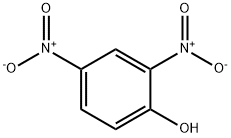
2,4-Dinitrophenol
Bezeichnung:2,4-Dinitrophenol
CAS-Nr51-28-5
Englisch Name:2,4-Dinitrophenol
CBNumberCB6358550
SummenformelC6H4N2O5
Molgewicht184.11
MOL-Datei51-28-5.mol
Synonyma
2,4-Dinitrophenol
1-Hydroxy-2,4-dinitrobenzol
2,4-Dinitrophenol physikalisch-chemischer Eigenschaften
| Schmelzpunkt | 108-112 °C (lit.) |
| Siedepunkt | 318.03°C (rough estimate) |
| Dichte | 1,683 g/cm3 |
| Dampfdichte | 6.35 (vs air) |
| Dampfdruck | 39(x 10-5 mmHg) at 20 °C (Schwarzenbach et al., 1988) |
| Brechungsindex | 1.4738 (estimate) |
| Flammpunkt | 11 °C |
| storage temp. | 2-8°C |
| Löslichkeit | Solubility Sparingly soluble in water; soluble in ethanol, benzene |
| pka | 3.96(at 15℃) |
| Aggregatzustand | crystals |
| Farbe | Light yellow |
| Säure-Base-Indikators(pH-Indikatoren) | 2.8(colourless)-4.7(yellow) |
| Geruch (Odor) | Sweet, musty |
| Wasserlöslichkeit | 0.6 g/100 mL (18 ºC) |
| Sensitive | Light Sensitive |
| Merck | 14,3280 |
| BRN | 1246142 |
| Kennzeichnung gefährlicher | T,N,Xi,F |
| R-Sätze: | 23/24/25-33-50-39/23/24/25-11-52/53-1 |
| S-Sätze: | 28-37-45-61-28A-36/37-16-7-35 |
| RIDADR | UN 1320 4.1/PG 1 |
| WGK Germany | 3 |
| RTECS-Nr. | SL2800000 |
| TSCA | Yes |
| HazardClass | 4.1 |
| PackingGroup | I |
| HS Code | 29089990 |
| Giftige Stoffe Daten | 51-28-5(Hazardous Substances Data) |
| Toxizität | LD50 (subcutaneous) for rats 25 mg/kg (quoted, RTECS, 1985). |




